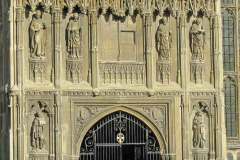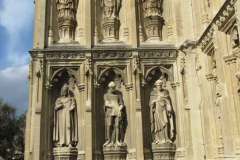Belgian-born Sculptor working in London
Theodore Phyffers was born in Louvain, Belgium, in 1821, and studied under the sculptor Professor Charles Geerts at the local university. He moved to London during the 1840s as a young sculptor. In London in 1847 he married Maria Colquohoun, daughter of a warder at Millbank prison. By 1851 they were living near Sloane Square with their sons, Felix and Victor, both sculptors, and three younger daughters. In the same year Theodore became naturalised British. A partnership with James Forsyth based on Landsdowne Yard near Russell Square was unsuccessful, and Theodore became bankrupt in 1855. He continued working alone at his Pimlico studios.
In 1863 the Dean and Chapter were looking into ways of filling the 74 vacant statue niches on the nave west wall and south west porch, inserted in the 1460s but with the original statues for many years destroyed or badly damaged. The authorities concluded that this was simply too expensive. They then found that Theodore was willing to provide statues at a cost of £24 each. By August 1865 he had produced over 60, which are duly listed in the Kentish Gazette with the names of donors who had financed each figure. (The misspelling of the artist’s name with Pfyffer in place of Phyffer was unfortunate.) A list with details of the carved inscription on each appears in Cowper (1897). The figures have not weathered well – many have lost inscriptions, facial features and limbs, despite the stated intention to toughen the Caen stone by silicating or ‘imparting a hardened surface by a chemical solution of flint’. ‘The general consensus amongst modern writers is that the quality of the carving was not of high standards, but to us they are rather more interesting than empty niches!
What to see:
- figures on the south face of the south west porch, including Augustine, Lanfranc, Anselm, Cranmer, Ethelbert and Bertha (Image 1)
- Further examples from the tower buttress at the west end of the nave, including Sudbury, Courtenay and Stratford (Image 2)
Sources: Cowper (1897); Kentish Gazette 15 August 1865; census returns 1851 and 1871
DL


